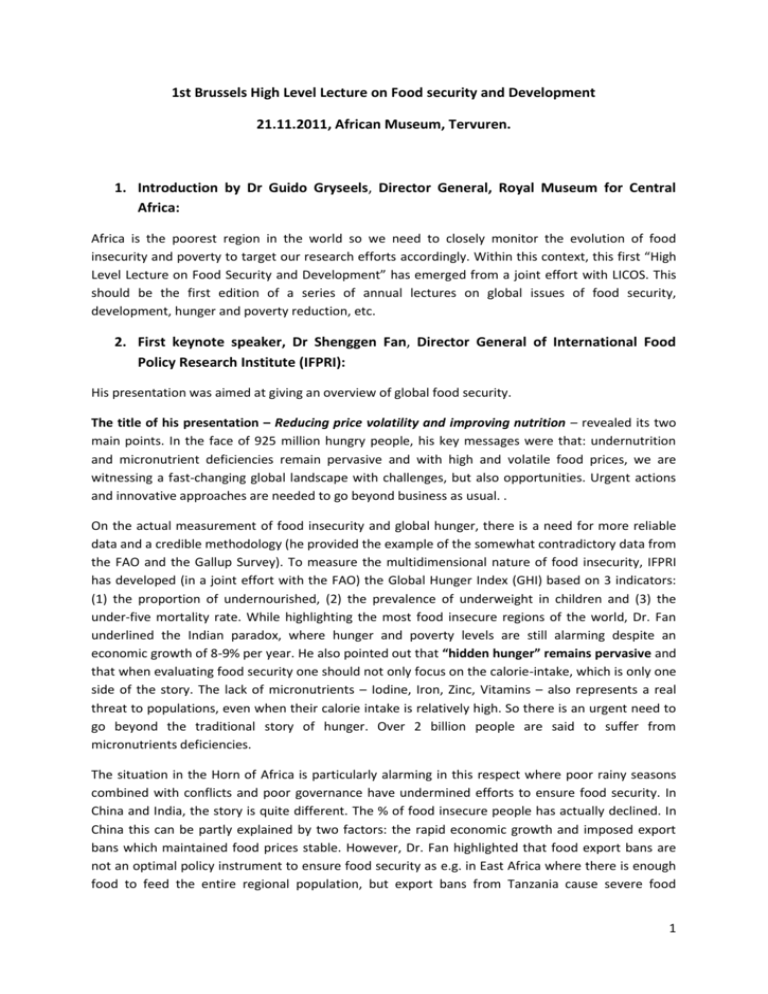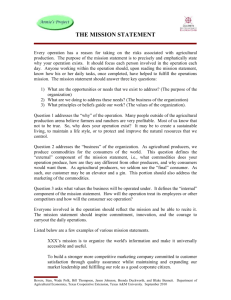Minutes Food Security 20111121
advertisement

1st Brussels High Level Lecture on Food security and Development 21.11.2011, African Museum, Tervuren. 1. Introduction by Dr Guido Gryseels, Director General, Royal Museum for Central Africa: Africa is the poorest region in the world so we need to closely monitor the evolution of food insecurity and poverty to target our research efforts accordingly. Within this context, this first “High Level Lecture on Food Security and Development” has emerged from a joint effort with LICOS. This should be the first edition of a series of annual lectures on global issues of food security, development, hunger and poverty reduction, etc. 2. First keynote speaker, Dr Shenggen Fan, Director General of International Food Policy Research Institute (IFPRI): His presentation was aimed at giving an overview of global food security. The title of his presentation – Reducing price volatility and improving nutrition – revealed its two main points. In the face of 925 million hungry people, his key messages were that: undernutrition and micronutrient deficiencies remain pervasive and with high and volatile food prices, we are witnessing a fast-changing global landscape with challenges, but also opportunities. Urgent actions and innovative approaches are needed to go beyond business as usual. . On the actual measurement of food insecurity and global hunger, there is a need for more reliable data and a credible methodology (he provided the example of the somewhat contradictory data from the FAO and the Gallup Survey). To measure the multidimensional nature of food insecurity, IFPRI has developed (in a joint effort with the FAO) the Global Hunger Index (GHI) based on 3 indicators: (1) the proportion of undernourished, (2) the prevalence of underweight in children and (3) the under-five mortality rate. While highlighting the most food insecure regions of the world, Dr. Fan underlined the Indian paradox, where hunger and poverty levels are still alarming despite an economic growth of 8-9% per year. He also pointed out that “hidden hunger” remains pervasive and that when evaluating food security one should not only focus on the calorie-intake, which is only one side of the story. The lack of micronutrients – Iodine, Iron, Zinc, Vitamins – also represents a real threat to populations, even when their calorie intake is relatively high. So there is an urgent need to go beyond the traditional story of hunger. Over 2 billion people are said to suffer from micronutrients deficiencies. The situation in the Horn of Africa is particularly alarming in this respect where poor rainy seasons combined with conflicts and poor governance have undermined efforts to ensure food security. In China and India, the story is quite different. The % of food insecure people has actually declined. In China this can be partly explained by two factors: the rapid economic growth and imposed export bans which maintained food prices stable. However, Dr. Fan highlighted that food export bans are not an optimal policy instrument to ensure food security as e.g. in East Africa where there is enough food to feed the entire regional population, but export bans from Tanzania cause severe food 1 shortages in Kenya. Dr. Fan mentioned that strategic (regional) food reserves could provide a solution. Away from malnutrition, Dr Fan also underlined the critical role played by price volatility, which he argues has increased in the last years (2 price spikes in the last 3 years). This increased price variability, he said, will hurt the poor, whether consumers or producers. He also highlighted the increased price transmission from world markets to local markets, as well as the debatable influence of financial speculation on price volatility. This is an ongoing debate: has price volatility on agricultural markets attracted speculators or has the speculation itself caused high volatility? We currently lack the data to answer this question with a high level of certainty. Amongst the other causes of price volatility, he also identified the strong correlation between food and oil prices and the rapid expansion of biofuels which intensified the competition over land. One of his main conclusions on high and volatile prices is that they hurt poor consumers, but he also raised the question of whether or not they also hurt poor producers. His answer was that food producers will only benefit from high prices if they are net sellers of food and if input costs do not rise in parallel. According to Dr. Fan, the smallholders have not been able to benefit from high food prices because of high transaction costs. Overall the causes of food security are very diverse: demographic changes, biofuels expansion, price volatility, natural constraints, poor governance, conflicts, rising energy prices, underinvestment in agriculture etc. Climate change and foreign land acquisition (called “land grabbing” in certain contexts) also represent threats to food security. However, they offer opportunities as well; agriculture can play a major role in climate change adaptation and mitigation and foreign land acquisition can provide jobs and economic growth to the region provided that the actors involved obey a good code of conduct, that there is sound regulations in place and that there is transparent information on land deals. Finally, we also need to make sure that investments are based on solid evidence. Food security is thus increasingly influenced by non-agricultural factors. One striking illustration of this evolution is the EU and US economic crises which will have broad implications (by jeopardizing economic growth around the world). The current challenging context offers opportunities for emerging countries which will see their role in the global economy increasing. The private sector has also seen its role evolving over the last years: today, major companies all have a Social Corporate Responsibility (SCR) plan and are increasingly making sure that their business practices are “socially responsible”. Another notable evolution of recent years is the transformation of supply chains where smallholders’ production goes through retailers and processors. In the face of these challenges and opportunities, urgent policy actions are needed to move towards business as “unusual”. This means: - Promoting smallholder productivity (invest in R&D and infrastructure, promote climate-smart agriculture, link smallholders to value chains and markets) Improving smallholder resilience (strengthen reach of productive social safety nets, increase access to risk management tools) Investing in productive social protection programs (better-targeted and more productive social protection to secure basic livelihoods, protect poor people from risk and vulnerability 2 - Reforming global food architecture (support transparent and free global trade, create global and regional grain reserves, minimize food-fuel competition, monitor global food prices and speculation, support global information systems) In this context, Dr. Fan emphasized the crucial role played by country-led programs. As research institutions, we should therefore contribute to local and regional capacity building. His main conclusions were: - The state of food security in the world is still very precarious A changing global landscape presents challenges, but also opportunities Urgent actions are needed to promote an agenda with greater support for food security Innovative approaches are needed to go beyond business as usual 3. Transition from first to second keynote speaker by Jo Swinnen, Director LICOS and Senior Research Fellow CEPS: Prof. Swinnen highlighted the intriguing paradox that most food insecure people in the world are food producers themselves and when prices go up, food security for those producers should increase. The second keynote speaker is EU Commissioner for Agriculture and Rural Development, Dacian Ciolos. He is the symbol of Europe’s tremendous evolution over the years; the fact that the current Commissioner is from Romania, the most “agricultural” country in the EU-27 clearly signals this EU evolution. 4. Commissioner Dacian Ciolos on the links between the EU Common Agricultural Policy (CAP) and global food security: Commissioner Ciolos started his speech by underlining that the food security issue was not only a problem of the developing countries. It is also a high political issue within Europe and therefore needs to be dealt with in a coherent and coordinated manner at the international level. He also underlined the recent interest of China and Middle-Eastern countries in acquiring land in Bulgaria for example, thereby signaling a somewhat “offensive” approach to food security. In this global context, the European Commission has proposed to maintain a strong budget for the CAP. Some calls had been heard to limit the national contributions to the CAP budget, thereby attempting to “renationalize” it; this would have been in complete contradiction with the calls being heard to reinforce the economic (and political) integration of the EU to overcome the current crises. The Commission has also attached three core priorities to this budget: (1) ensuring food security, (2) managing natural resources in a sustainable way and (3) maintaining territorial cohesion. The main idea is thus to maintain agricultural support in Europe but in a more consistent and sustainable manner, e.g. by dealing with agricultural and environmental issues within the same policy (rather than having an administrative and unrealistic distinction between them). Farmers today should therefore be seen as food producers AND public goods providers (rather than one OR the other). The goal of the Commission is to make sure that European agriculture becomes economically but also ecologically competitive. 3 On the impacts of direct payments on developing countries, Commissioner Ciolos insisted that the CAP was not a dumping policy anymore, as support had been decoupled from production and as export subsidies had been almost completely abolished (representing only 1% of the current CAP budget). He also underlined that the EU is now focusing on exports of high quality products, which do not undermine the production of basic commodities in developing countries. The EU is also the region of the world which is making the biggest effort in terms of importing products from developing countries (it imports more from developing countries than the US, Canada, Australia, NZ, Japan together). To ensure food security at the global level, Commissioner Ciolos believes in the development of well-designed agricultural policies at the regional level. The idea here would not be for the EU to impose its model to other regions of the world but rather to help Africa for example to develop its own agricultural policy. This idea of “regional management” is crucial today, in the age or resource scarcity and environmental constraints. The EU should also make sure that its agricultural policy is coherent with its trade and development policies and he reminded that Europe had made a great effort to try and reach the Doha Agreement, favourable to developing countries. He also emphasized the new role played by research and innovation in meeting future challenges. The Commission would like to develop specific instruments aimed at reducing the distance between the production of knowledge and its application on the ground. Finally, regarding the impact of price volatility, Commissioner Ciolos highlighted the crucial role played by market transparency. As a conclusion, he called the FAO to go beyond its current mandate and endorse a more important role to ensure a better coordination of agricultural policies around the world. A reformed FAO could make a significant contribution to the food security effort, while at the same time ensuring more transparency on agricultural markets (which would reduce price volatility). 5. Q/A The following questions/issues were raised: Dr. Fan mentioned that strategic (regional) food reserves could provide a solution to food insecurity, but examples from the past have shown that strategic food reserves (as e.g. in China) were extremely expensive and inefficient. Dr. Fan explained that it is very important to take into account factors as the local population (and population growth), the local needs, optimal location etc. in setting up efficient and cost-effective strategic (regional) food reserves that could serve as a short-term solution to food insecurity. Which policy measures could transform net consumers into net producers? In other worlds, which are the optimal policies which would benefit both the consumers and the producers? Dr Fan emphasized that stable prices benefit both groups, but that volatility also affects both groups. 4




![[These nine clues] are noteworthy not so much because they foretell](http://s3.studylib.net/store/data/007474937_1-e53aa8c533cc905a5dc2eeb5aef2d7bb-300x300.png)